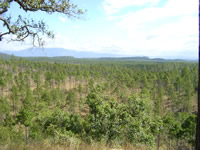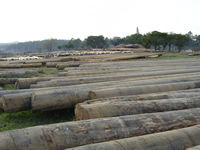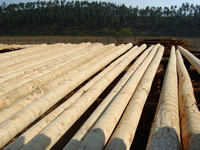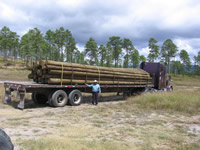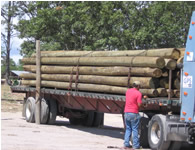
Utility Poles
Caswell Forest Products provides its customers with "ready to install" utility poles. The mechanical properties of Caribbean pine poduces an outstanding pole. The fact that the region in which our properties occur is a "fire sustained pine climax forest" results in a natural pruning of limbs below 20 feet. Natural and plantation stands are densely populated resulting in low taper rates and very straight trees. We produce our own tree-poles. We manage for pole production, producing over 600 poles per acre on thousands of acres. We also harvest under a very strict sustained yield program, which will produce high volumes of quality poles indefinitely. We also purchase pole logs from forests in the region to augment our own supply. (click images to enlarge)
GOAL.Our goal is to provide our customers with the best possible source of poles to meet their needs - quality, delivery, price and service. We strive to improve on these daily. If you have suggestions on how we may improve on any of these please contact the director of customer service at info@caswellfp.com.
Pole Sizes.
The most abundant pole sizes are (in their order of highest class
abundance first):
- Class 5 : 25(7.62), 30(9.14), 35(10.67), 40(12.19) feet(meters) lengths.
- Class 4 : 25(7.62), 30(9.14), 35(10.67), 40(12.19) feet(meters) lengths.
- Class 3 : 30(9.14), 35(10.67), 40(12.19), 45(13.72) feet(meters) lengths.
- Class 6 : 25(7.62), 30(9.14), 35(10.67) feet(meters) lengths.
- Class 7 : 20(6.10), 25(7.62), 30(9.14), 35(10.67) feet(meters) lengths.
- Class 9 : 20(6.10), 25(7.62), 30(9.14) feet(meters) lengths.
- Class 2 : 40(12.19), 45(13.72), 50 (15.24), 55(16.76) feet(meters) lengths.
While these are the most abundant classes and lengths we produce, we can also produce shorter poles of each class and longer poles of some classes. Please contact us with your Utility Pole and Piling requirements info@caswellfp.com and we will serve your needs if we can.
Grading,
Culling and Handling.
All grading
and culling are performed in accordance with the American National Standards
Institute "ANSI 05.1-2002 American National Standard for Wood Products
- Specifications and Dimensions". The Class size specifications provided
for Southern Yellow Pine (and Douglas Fir) are used in classifying Pinus
caribea due to their comparable mechanical strength properties.
Prominent vertical growth, natural pruning from fire and shade, and absence
of deformities makes P. caribea grown in our region ideal trees for utility
poles and marine pilings. If you require poles graded to some other specification
please contact us with your particular needs. We were the first pole production
facility in Honduras to provide ANSI standard poles and are the only facility
to make a training DVD on specific procedures for Grading, Culling and
Handling poles according to ANSI standards. We also provide specific instructions
in Spanish tailored to the vocabulary of the plant personnel assigned
those responsibilities. To further ensure consistent adherance to the
standards and provide the highest quality pole possible we have a bonus
program targeting the lowest possible rejection rate by our customers.
Peeling.
All poles are debarked and peeled by our Mobark peeler. Special care is
given to ensure thorough peeling and smooth machined surfaces of all poles.
Poles are graded immediately after peeling and placed in the yard by class
and length. Poles with defects discovered after peeling are separated
for use as pilings, fence posts or are sent to the saw mill - depending
on the rejection criterion. Residual bark or cambium tissue is removed
at time of grading and sorting.
Drying.
All poles are dried to less than a minimum of 26% residual moisture (as
specified). Our normal target drying is to 20% residual moisture. This
is performed under a combination of air-solar and kiln drying. This combination
is used to achieve the greatest possible uniformity of residual moisture
distribution in the wood. This provides for a greater uniformity of absorptivity
in the treatment process and superior field performance of the final product.
The relative humidity, air movement and solar incidence at our production
site - at just over 4,000 feet above sea level - provides ideal drying
conditions and assists in containing production costs. The pole drying
is finished in our pole drying kiln. The kiln will hold approximately
200 class 5:35 and 40 poles per drying cycle. Our kilns are wood fired
furnaces with high capacity boilers and pipe systems. The kilns are dual
sided to enable loading the next charge of wood within minutes of removing
the previous charge. This provides optimal use of the kilns - they are
never empty for more than a few minutes.
The kiln furnaces are all wood-fired. The peeler waste and limbs of harvested trees are all burned in the kiln furnaces. This greatly reduces fuel loads in the forest and waste accumulation from the peeler - reducing the danger of fire in the nearby forests.
Finishing.
We brand all poles at 4 feet above ground level. During this process all
of the residual knots are planed to the pole surface and any residual
cambium or bark is planed from the pole. We also routinely drill all of
the holes and any special order top cut required to deploy the poles.
These holes are best drilled prior to treatment for the best service life
of the pole. We can price poles with and without holes.
Treatment.
Our pressure treatment staff are unsurpassed in years of experience and
knowledge regarding the pressure treating process and the production of
quality poles. Whether the product requires 0.4 (fence post, lumber),
0.6 (utility poles), or 2.4 (special marine use) pounds per cubic foot,
each pole is treated to the specified rate. Moreover, the drying process
and extent results in a more uniform absorption radially and longitudinally
- providing superior field life of the pole. All treatment today is performed
with CCA - Chromated Copper Arsenate, the treatment substance of choice
in the replacement of Creosote. We can treat poles up to a maximum of
80 feet in length. Our treatment cylinder is the largest operating cylinder
in Honduras. We routinely treat 2 lengths of 30 to 40 foot long poles
per charge - reducing cost per pole.
Transportation.
We can arrange for transport to anywhere in the world. We can ship to
eastern hemisphere destinations through port San Lorenzo on the west coast
or the western hemisphere and near-east destinations through the Puerta
Cortez. Shipping to all ports in the Caribbean basin is highly available
and very affordable from the Puerto Cortez facility. Some destination
ports are serviced only with containerized freight - limiting pole lengths
to just under 40 feet. We can load containers with poles of any class
and prepare for shipment to any serviced port.
We routinely provide over-land freight to many destinations in Central America - Nicaragua, Costa Rica, Panama, El Salvador, Belize and Guatemala. We can also provide over-land to destinations in Mexico. While the cost of freight is increasingly a primary cost of delivered poles, we are taking every possible measure to control and reduce these costs wherever possible. Our transportation business partners work very hard to secure and maintain our business. We pass these savings on to our customers. We also provide all document preparation and can provide documents in formats customized to accomodate the special requirements of each destination port to avoid delays and additional costs.
Our Commitment
to our Customers.
If it is not an ANSI Standard compliant pole and it came from us (has
our brand) then we will replace it at our cost - including shipping.
If a pole (purchased from us) is damaged in a natural disaster and must be replaced, we will provide replacement poles as soon as physically possible out of our disaster readiness inventory.
All purchase orders are filled in a first-in and first-out basis, regardless of price, quantity or class. All purchase orders are filled at the earliest possible time unless specified otherwise by the customer.
We will earn your business with every single pole, delivery, document and conversation. If we need to perform anything differently in order to improve service and value, we want to know. If we can do it, it will be done.
